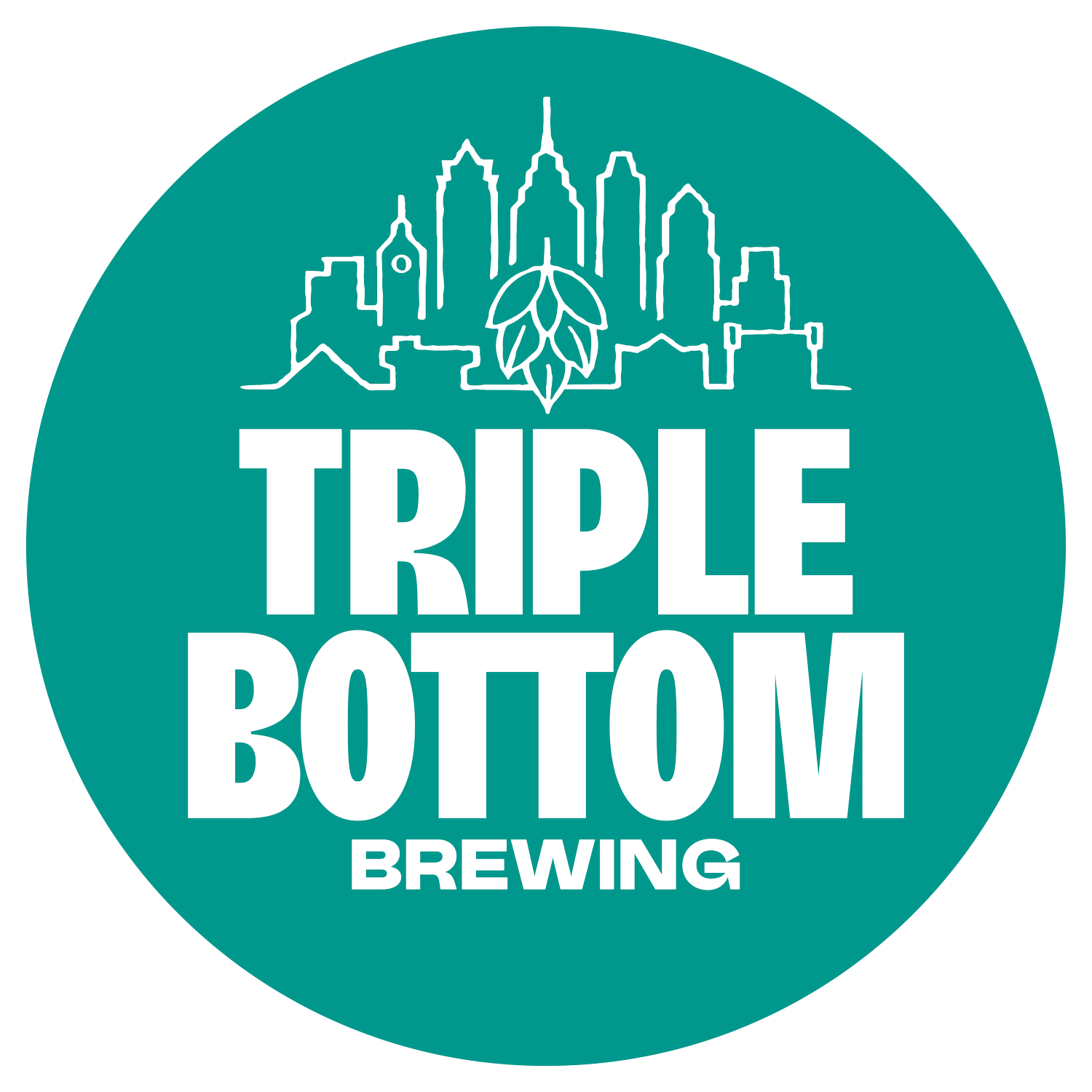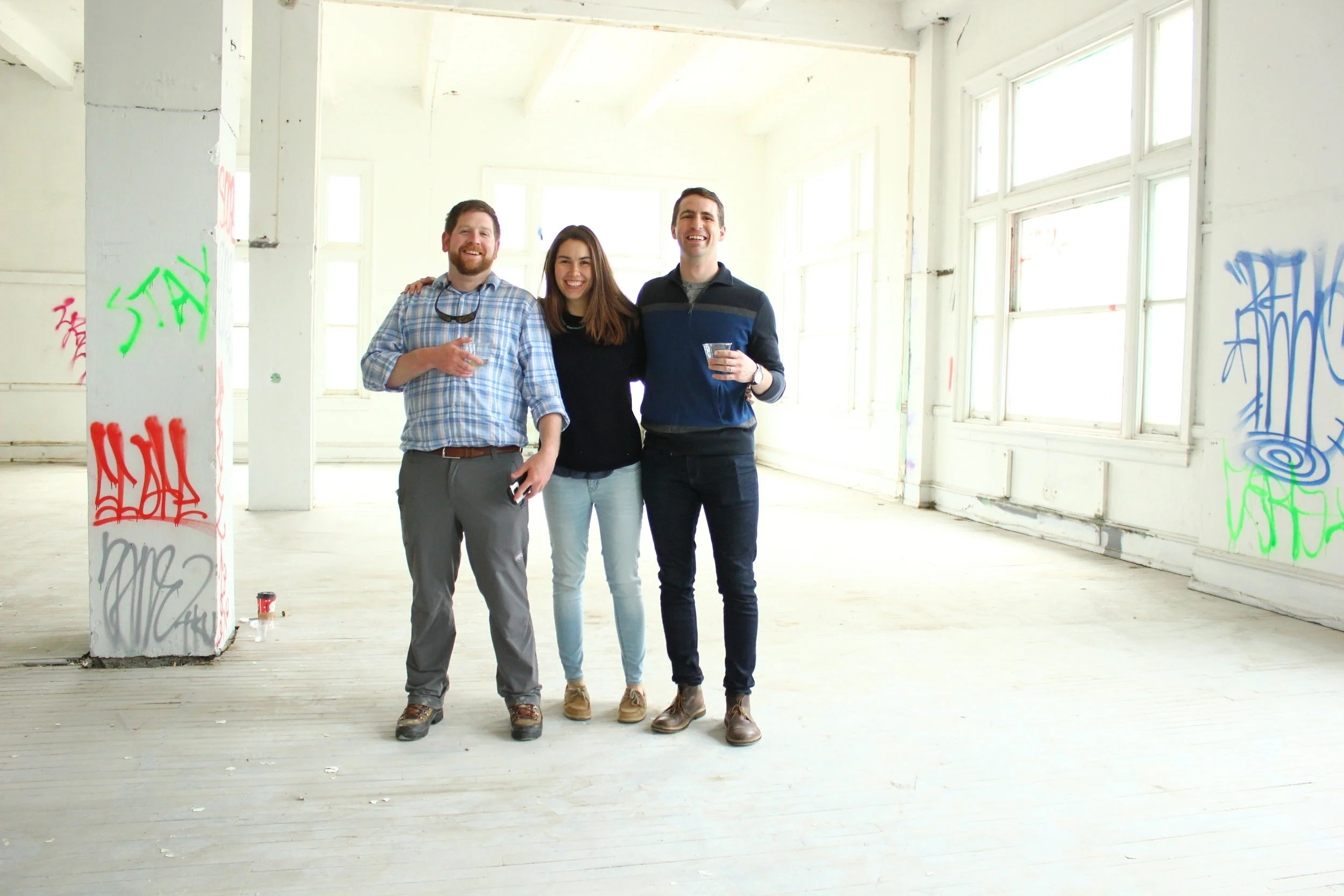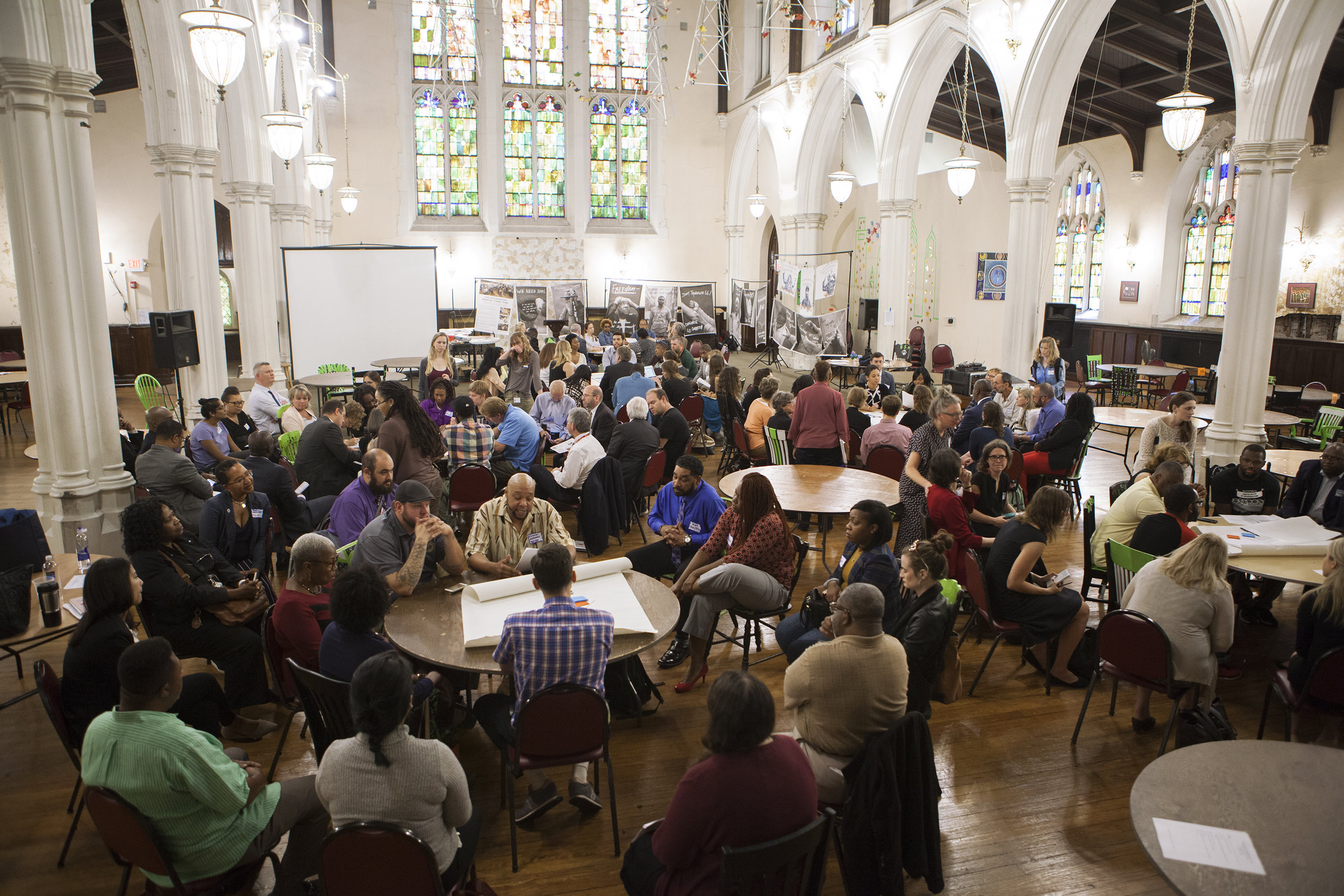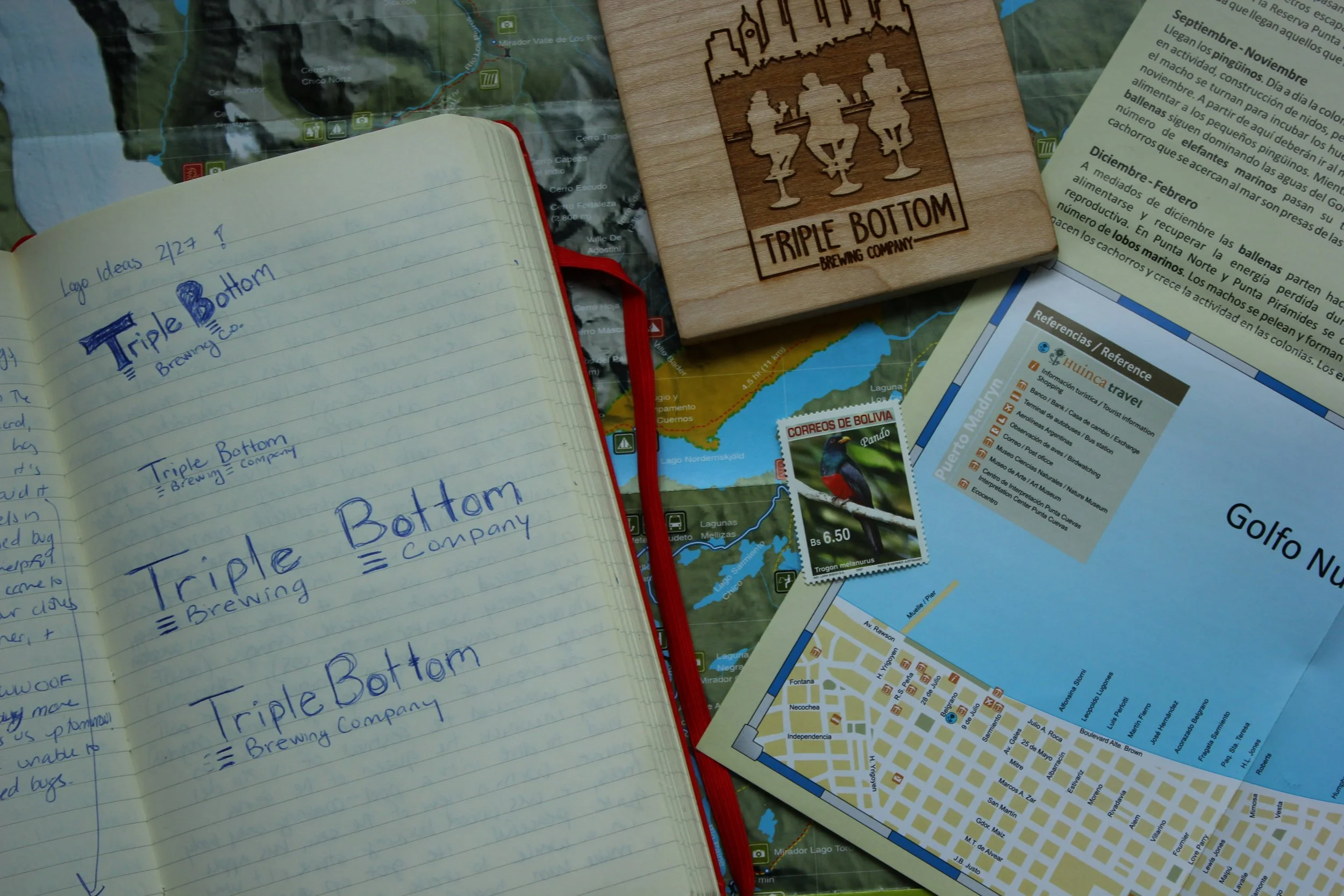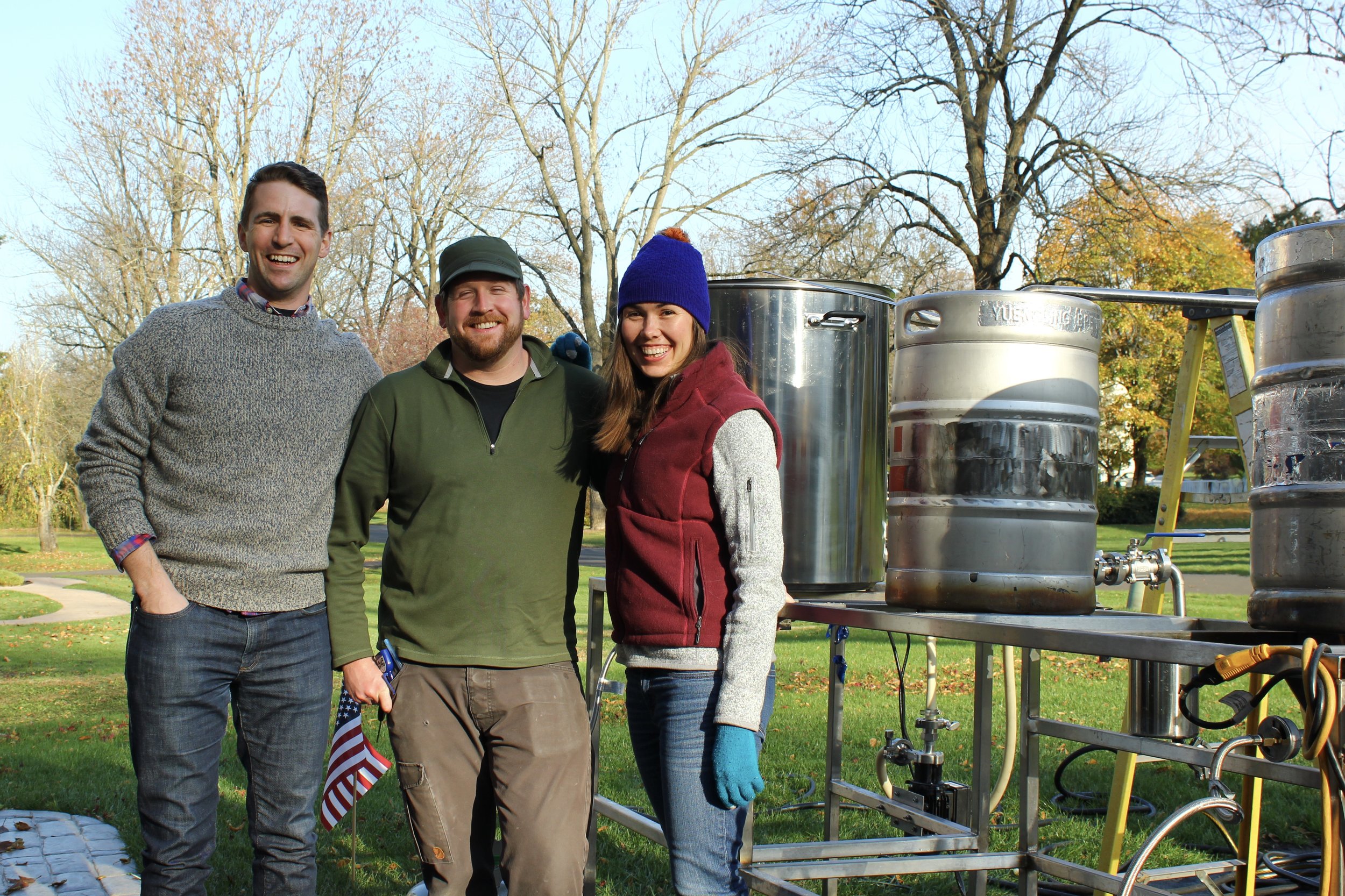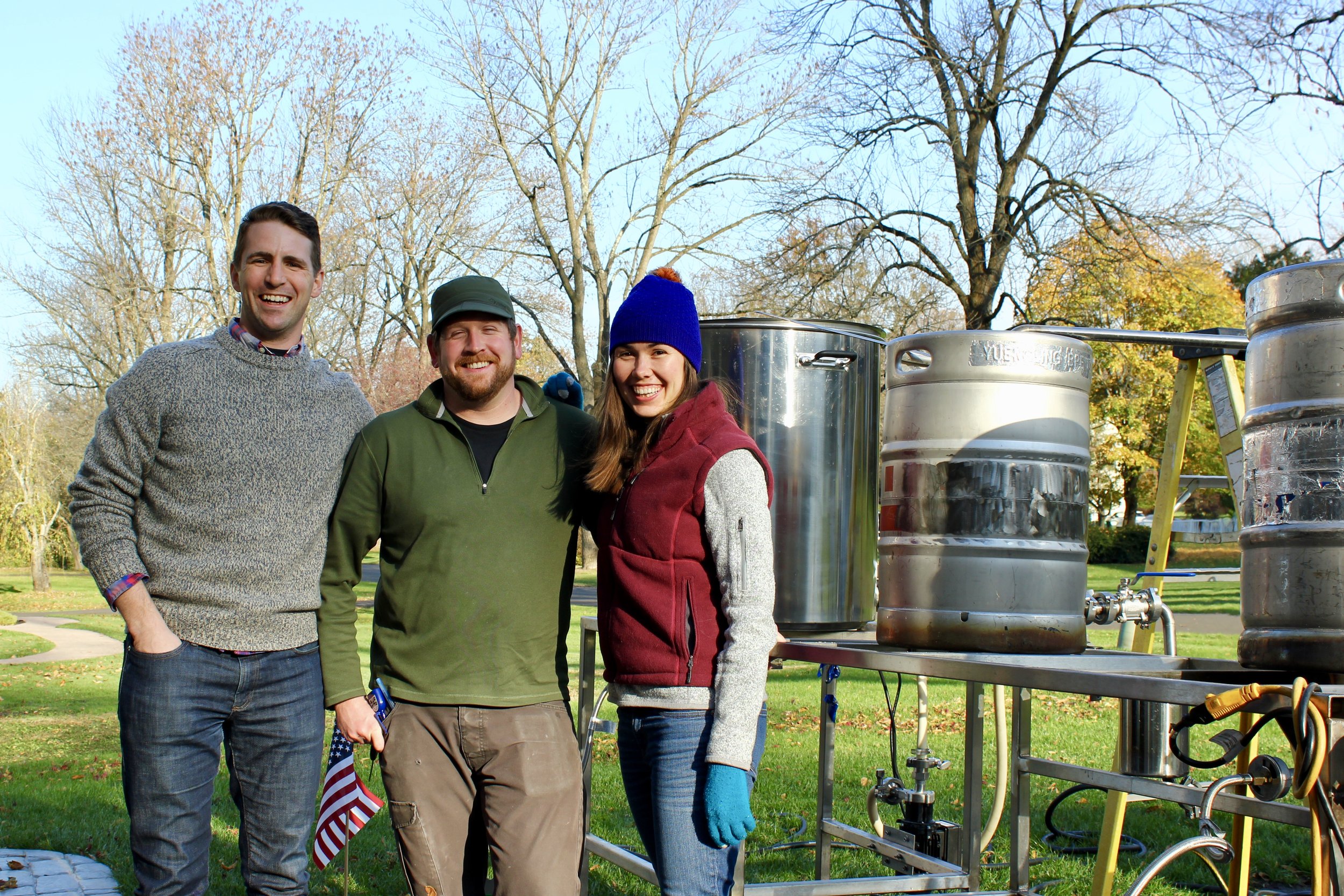Spotlight on Green City Works
It was one of those weeks where I was on hold with the IRS for multiple hours, working through various permit and license applications, and spending a lot of time talking to our lenders (who are wonderful, but let’s be honest, not where I turn when I need inspiration). My conversation with Brian and Alissa of Green City Works was a much-needed reminder to keep our eyes ahead, because at the other side of all this is the opportunity to make a beautiful product and also make a difference in people’s lives—just like Green City Works does.
Last week, I had the pleasure of meeting with some of the team at Green City Works — a subsidiary of University City District in West Philly that does truly spectacular landscaping, and supports a remarkable group of people who would otherwise have a hard time finding a job.
Photo by Ben Tran, courtesy of University City District.
It was one of those weeks where I was on hold with the IRS for multiple hours, working through various permit and license applications, and spending a lot of time talking to our lenders (who are wonderful, but let’s be honest, not where I turn when I need inspiration). My conversation with Brian and Alissa of Green City Works was a much-needed reminder to keep our eyes ahead, because at the other side of all this is the opportunity to make a beautiful product and also make a difference in people’s lives—just like Green City Works does.
If you’ve ever been to the Porch at 30th Street Station, or wandered through University of the Sciences in the last year or two, you have seen some of the joy and beauty that Green City Works brings to University City. Green City Works is a nonprofit landscaping social enterprise that provides professional landscaping services while also being highly conscientious about its responsibilities as an employer and community member. As Brian told me last week, “there’s talent all over West Philadelphia. We’re just finding another way of unearthing that talent.”
Photo by Ben Tran, courtesy of University City District.
Green City Works hires people who have completed University City District’s job training program, the West Philadelphia Skills Initiative. All of the enterprise’s team members work 40 hours a week, year round — which is unusual in the landscaping business, where most workers get laid off for winter. While Green City Works provides ongoing coaching to its team, both in soft skills and technical skills, it really ramps up this coaching in the winter, when landscaping is a lot slower. All of their landscapers get benefits and a living wage, and the support of an employer who recognizes their strengths and wants to see them thrive.
It is so invigorating to share ideas and learn from the experiences of people like Brian, Alissa and the Green City Works team. Thank you for the work you do making Philly more beautiful and lifting up the strengths of so many people who don’t normally get the chance to share them. We can’t wait to see how you continue to grow and make your mark on this city!
2018 Craft Brewers Conference: 14,000 Beer People in One Place
That’s right. 14,000 beer people. In one place.
Two years ago, the Craft Brewers Conference was an incredibly daunting event, despite it being on our home turf in Philadelphia. At CBC Philly, Billy and I were new to this commitment that we were going to build Triple Bottom. We felt like we had everything to learn, and nothing to offer. We looked around us at teams coming into town from some of our favorite breweries, and felt a serious case of imposter syndrome.
Returning to CBC two years later, we realized how much has changed.
That’s right. 14,000 beer people. In one place.
Two years ago, the Craft Brewers Conference was an incredibly daunting event, despite it being on our home turf in Philadelphia. At CBC Philly, Billy and I were new to this commitment that we were going to build Triple Bottom. We felt like we had everything to learn, and nothing to offer. We looked around us at teams coming into town from some of our favorite breweries, and felt a serious case of imposter syndrome.
Returning to CBC two years later, we realized how much has changed.
First of all, imposter syndrome has gotten a bit more comfortable, out of necessity. Every day, we are doing something we’ve never done before — whether it’s signing a lease, meeting with City Council, or talking through building plans with the folks at Philly’s Licensing and Inspections department. With all this newness, we’ve had to learn to live with the “am I doing this right?” question every day.
But imposter syndrome has also decreased somewhat because of how much we’ve learned and done over the last two years. This year’s CBC helped me see that in a big way. A lot of the lessons I took away from CBC this year resonated much more deeply because we’ve now got a foundation of knowledge and experiences we can relate them to. I could commiserate with other early stage breweries about finding a location, share ideas about HR policies, and actually add value to conversations I didn’t feel I could contribute to before. I walked through the expo, which is an insanely huge assembly of vendors, with a sense of purpose: we need a boiler, we need our floors finished, we need glassware. (Obviously, having Kyle to tell me who I should talk to about said boiler and floors helped greatly).
Nashville is no Philly in the street art department, but we still found some gems.
We’re not the only ones who have progressed over the last two years, though. This year’s CBC debuted its first ever leadership track, which included a lot of seminars about building an inclusive industry and leading a socially responsible business. The Brewers Association’s first diversity ambassador, Dr. J, led a brilliant conversation about how we as an industry can be more self aware of who we welcome and who we (perhaps unintentionally) don’t. It felt like there were more women participating (though I haven’t found any stats on attendance to verify that, just a general feeling of not being quite so alone). These are all issues that we have been committed to addressing since day 1 of Triple Bottom, and it was so energizing to hear such familiar conversations finally having a broader reach.
In a sea of 14,000 beer people, I was worried I’d feel lost and overwhelmed. Instead, I felt bolstered, connected, and inspired. If I sat down by myself for lunch, barely any time would pass before someone sat beside me and wanted to learn what I was up to, and how they could help. There is a tremendous generosity of spirit throughout the craft brewing industry. It’s one of the main reasons we chose to start a brewery, and it was pretty amazing to see that generosity rise to the surface, even in such a huge crowd. So thank you, CBC. This just keeps getting better. Can’t wait for the next one. – Tess
Paul Saginaw, co-founder of Zingerman's in Ann Arbor, gives the keynote on building an inclusive business deeply rooted in its community.
We have a home!
It feels so great to have an address, to be able to point to a place on a map and say that we're building something exciting right here.
After nearly two years of searching, I admit that my greatest emotion since signing our lease has been relief — punctuated by tremendous moments of excitement. It’s like a big exhale. It makes all of our ideas and plans and partnerships much more concrete. They have weight. They have a future. They have a home. And, while much uncertainty still lies ahead, it’s so much easier to face uncertainty when you have a secure place to call home.
It feels so great to have an address, to be able to point to a place on a map and say that we're building something exciting right here.
After nearly two years of searching, I admit that my greatest emotion since signing our lease has been relief — punctuated by tremendous moments of excitement. It’s like a big exhale. It makes all of our ideas and plans and partnerships much more concrete. They have weight. They have a future. They have a home. And, while much uncertainty still lies ahead, it’s so much easier to face uncertainty when you have a secure place to call home.
And it really is a wonderful home! 915 Spring Garden is a beautiful building that was built in the early 1900s to be the offices of the Reading Railroad (of Reading Terminal and Rail Park fame). It’s five lofty stories with big windows and tons of natural light. For several decades, it housed a YMCA for railroad workers, and a room where people newly arrived in the United States via Ellis Island or elsewhere could meet friends or receive guidance to help them navigate their new city. We love this part of 915’s past, because it’s all about bringing together and lifting up the Philadelphia community. The building has had subsequent lives, including as artist studios, but has been lying dormant for the last few years.
We will occupy part of the first floor, and are already making plans for designing a space that will make you smile with joy when you walk through our doors. It brings us so much joy to envision welcoming you there. (Really, grinning right now thinking of it!)
But we don’t want to get carried away with our plans before really engaging with our neighbors. This neighborhood has experienced a lot of change in recent years, including a rebrand as the “Spring Arts” district. While many of these changes are positive, they are still changes — and change can be hard. We recognize that one of the big changes is in the use of the building itself. Before it was vacant, it was home to art studios — which was a wonderful use of the space. Several years ago, there was an eviction that disrupted a lot of artists’ lives and livelihoods, and the building fell vacant. While our landlord purchased it some time after that, we understand that this building may still trigger unhappy memories for some people. We are here to listen to your thoughts and ideas about how to we can contribute to a positive future for 915 Spring Garden and our surrounding community, if you ever would like to share them with us. We want Triple Bottom Brewing Company to be a happy place for everyone.
To our friends and neighbors in Spring Garden/West Poplar/Callowhill — please stay tuned for opportunities in the future to brainstorm ways we can play a positive role in our community. And to everyone (all three readers of this blog!), we hope you’ll follow along as we bring Triple Bottom to life. The best is yet to come!
An Ode to (Waste)Water
In honor of Earth Day coming up, we want to celebrate one of the most important things the earth gives to all of us, and to the beer we brew: water.
Breweries use a lot of water. Bigger breweries (not craft) use an average of just over four barrels of water for every barrel of beer produced, and craft breweries — which don’t have the efficiencies of scale that the big guys do — on average use even more. While beer is 95% water (source: Brewers Association), most of the water used in the brewing process is actually used for cleaning and packaging, and ends up going down the drain.
In honor of Earth Day coming up, we want to celebrate one of the most important things the earth gives to all of us, and to the beer we brew: water.
Breweries use a lot of water. Bigger breweries (not craft) use an average of just over four barrels of water for every barrel of beer produced, and craft breweries — which don’t have the efficiencies of scale that the big guys do — on average use even more. While beer is 95% water (source: Brewers Association), most of the water used in the brewing process is actually used for cleaning and packaging, and ends up going down the drain.
Last weekend, we got the chance to learn what happens to the water once it leaves our brewery through a tour at the Southeast Water Pollution Control Plant. I will admit that we were probably the most enthusiastic people on the tour, but it was really fascinating. If you have the chance to visit, we recommend it! We were welcomed by Debra McCarty, Commissioner of the Philly Water Department (and the first woman to ever have that job!). A series of exhibits offered information on topics ranging from green stormwater infrastructure to solid-waste-eating microbes. But best of all was the in-depth, guided tour of the treatment process at the plant.
We weren't allowed to take pictures at the plant for security reasons, so here's a photo of the Water Works on a very cold day. This used to be where Philly pumped drinking water from the Schuylkill River.
Philly has three treatment plants, which collectively treat 500 million (!!) gallons of sewage each day. That number increases during storms, because our stormwater and sewage share a pipe as they travel under our streets. On a normal day, our sewage water goes from really gross to cleaner than the water in our rivers in six hours. On days with heavy rain, the volume that our treatment plants have to handle goes up significantly. Even with the extra capacity the plants have, they may have to speed up the treatment process to take only two hours, which means the water they release back into the river isn’t quite so clean. But don’t worry! Those occasions are rare, and on a normal day the water gets so clean that even taking into account these high-volume days, the water released back into the river is still on average much cleaner than the river water itself. This is especially impressive considering that our beloved Delaware and Schuylkill Rivers are cleaner than they’ve been in 100 years.
Philadelphia didn’t start treating its sewage until 1954. Imagine what the rivers were like then! Yikes. The process has changed and improved a lot since it was instituted, but it is also amazing how much has stayed the same. First, large objects, such as logs and traffic cones, are screened out. Then water is pumped through a much smaller screen, to get rid of small pieces of trash. It is then sent through canals, where the speed of flow is controlled. The water is slowed down a bit to allow all the grit, sand and kitty litter to drop out. This gets sent to the landfill. Then it’s slowed down even more to allow biosolids to fall out. These get picked up by a contractor and turned into pellets, which can be used as fuel or fertilizer. After that, hungry microbes are added to eat up all the rest of the bad stuff in the water. Once the microbes have feasted and been filtered back out, the water is basically clean. A chloride treatment kills any remaining germs, and finally, the water flows back into the river, where fish can live in it, people can swim in it, and the drinking water plants can pump it through their cleaning processes so we can all drink it — and use it to brew beer!
This beautiful piece of art shows how interconnected our city and rivers are. It was drawn for the Green City, Clean Waters Art Contest by Olivia Forti, and found on Flickr Commons. Thank you for the great illustration!
Because breweries contribute a lot of wastewater to the sewer system, we have to be responsible about treating our water before releasing it. We’re designing our treatment process so that we can manage the temperature of the water we release, the ph balance, and the amount of suspended solids in it, so that we’re not bogging down the Water Department’s treatment process. We’re also trying to use water as efficiently as possible in the first place. Simple things like using a mop to clean the floors of the brew house, rather than using a hose, can make a big difference. We’ll have a tank to store water with cleaning chemicals, so we can reuse those chemicals for their full life span as we clean our equipment — rather than dumping all that water down the drain after each use. To start, we won’t be doing much packaging, which you might be surprised to learn uses up a lot of water. (Rinsing each can or bottle has an impact!). As we grow into packaging though, we’ll explore ways we can recapture and reuse that rinse water, to keep our water footprint down.
As a triple bottom line business, we are doing our best to minimize our impact on the planet, but we know we can always do better. As we grow, we’ll try to improve our processes in support of our planet, just as the Philly Water Department has done and continues to do. Thanks so much for the huge role you play in keeping our rivers clean and our beers delicious, Philly H2O! It was great to learn more about how you work.
Spotlight on The Philadelphia Reentry Coalition
For us, the topic of our team — how we treat each other, the professional development opportunities we offer, and the challenges we have to prepare for — is especially important because of our mission to create jobs for people who have traditionally been excluded from the mainstream workforce. This mission is core to who we are, but we are not bringing it to life on our own. We are working with a cadre of advisors, collaborators, and big thinkers to develop the skills, resources and empathy we need to best support our team. This city is filled with people who are devoting their minds and their time to making life better and fairer for everyone. We’ve been lucky to get to know so many of these good people, and are excited to lift up some of their work here.
I would guess that when you think about what it’s like to start a brewery, you imagine people wearing boots and flannel productively buzzing around big stainless steel tanks, brewing and tasting beer, as laughter and loud noises from the construction site punctuate the air. And this is all true — or will be once we have a home.
But any brewery will tell you that there is so much else that goes on behind the scenes — from the miles of documents a business needs to get a loan, to the always evolving conversations with patient graphic designers helping us try to look our best, to the blue sky discussions about what our culture and HR policies will be.
A stakeholder meeting co-hosted by the Philadelphia Reentry Coalition and the Philadelphia Reentry Think Tank. Photo by Mark Strandquist of the Reentry Think Tank.
For us, the topic of our team — how we treat each other, the professional development opportunities we offer, and the challenges we have to prepare for — is especially important because of our mission to create jobs for people who have traditionally been excluded from the mainstream workforce. This mission is core to who we are, but we are not bringing it to life on our own. We are working with a cadre of advisors, collaborators, and big thinkers to develop the skills, resources and empathy we need to best support our team. This city is filled with people who are devoting their minds and their time to making life better and fairer for everyone. We’ve been lucky to get to know so many of these good people, and are excited to lift up some of their work here.
At Triple Bottom, some of our team members will have overcome some really challenging experiences to be with us, including experience in the criminal justice system. So we’ve been learning a lot from organizations that work in reentry — the process of someone returning to their community from jail or prison.
Last month, I attended the Philadelphia Reentry Coalition’s quarterly stakeholder meeting. The Reentry Coalition connects organizations and agencies working on reentry so they can share resources and information to advance the collective vision that every person released to Philadelphia from jail or prison succeeds as a productive member of the community.
The number of organizations involved in this work is overwhelming — it’s a huge and diverse ecosystem, which the Reentry Coalition has been helping to make more cohesive and collaborative since it was founded in 2012. The Coalition also spearheads research to help understand the current state of reentry in Philadelphia, so that we can the measure progress in reducing recidivism rates. And, it hosts stakeholder trainings to help equip members to be more effective in their work. Last week, I attended a training on trauma informed care, which was led by the Director of Behavioral Health and Justice Services for the City of Philadelphia. I came away having absorbed some big ideas and concrete tools that will help us to create a culture based on empathy at Triple Bottom.
We’ll be silly, and challenge each other, and work together to brew great beers, but our hope is that all of our creativity and collaboration and growth is founded on appreciation for what everyone brings to the table, no matter where they were before. And we’re so lucky to be in a city with so many smart, generous organizations like the Reentry Coalition, who are helping us get to where we want to be. Cheers to you guys.
Photo by Mark Strandquist of the Philadelphia Reentry Think Tank.
And then there were three.
As most great relationships seem to do these days, our relationship with Kyle got its start on the internet.
Bill's and my homebrewing was decent, but was never going to be the foundation of a brewery. On our most adventurous days, we brewed with a hybrid of malt and extract, but we had neither the equipment nor the expertise to begin developing creative, replicable recipes. It was abundantly clear that we needed a partner.
As most great relationships seem to do these days, our relationship with Kyle got its start on the internet.
Bill's and my homebrewing was decent, but was never going to be the foundation of a brewery. On our most adventurous days, we brewed with a hybrid of malt and extract, but we had neither the equipment nor the expertise to begin developing creative, replicable recipes. It was abundantly clear that we needed a partner.
For several months, we put out feelers through our friends and family, looking for someone who could round out our team. But it turns out that our extended network didn’t actually know that many brewers. We did meet a handful of wonderful people, from talented home brewers, to people already working in commercial breweries. But nobody was quite the right fit. It’s hard to ask somebody you don’t know to jump off a cliff with you, especially when you aren’t sure when exactly you’re going to be taking that jump and whether you’ll land on your feet. Our new partner had to consider a lot of factors before deciding to take this risk with us, and vice versa. Eventually, we turned to ProBrewer, which is like a Craigslist for the brewing industry, and a really useful tool. Bill and I wrote a short description of the type of brewery we are trying to build and the type of partner we were looking for, and nervously sent it out into the worldwide web.
The response was overwhelming, and is such a testament to the collaborative spirit of the craft brewing industry. We heard from people who were interested in the job, and we heard from even more people who — inspired by our social mission — reached out just to offer advice and support.
And that’s how we met Kyle. He had been backpacking off the grid (in typical Kyle fashion) when we posted, so was one of the last replies we got. It only took a few meetings for all of us to realize that this would be a good partnership. Kyle laughs a lot and is super smart. His experience brewing beer is staggering. And we all trusted each other almost immediately, which is kind of crazy when you think about it.
After brewing together through all sorts of weather on our pilot system in Kyle’s driveway, grappling with the process of finding a location and getting bank loans, and diving deep into discussions about company culture and HR policies, I feel luckier than ever that I get to jump off a cliff with this team. Here’s hoping we land on our feet!
Our first team photo. We were so young and awkward then!
Origin stories.
Triple Bottom was born from a “wouldn’t it be amazing if…” kind of conversation over a steak dinner in South America. As all great ideas do, right?
Bill and I had just left Washington, DC, where we had been working in community and economic development for several years, and were very fortunate to be able to take a trip before beginning graduate school. (It may be worth noting here that Bill and I are married, so we hang out a lot.)
Triple Bottom was born from a “wouldn’t it be amazing if…” kind of conversation over a steak dinner in South America. As all great ideas do, right?
Bill and I had just left Washington, DC, where we had been working in community and economic development for several years, and were very fortunate to be able to take a trip before beginning graduate school. (It may be worth noting here that Bill and I are married, so we hang out a lot.)
While in DC, we had become excited about craft breweries. We were not remotely nerdy about our beers, but we did really appreciate the experience of visiting a brewery. We liked learning about how beer was made while holding that beer in our hands. And we liked the sense of connection we felt with other people visiting the brewery, too. People come to breweries looking for a story, not just a drink, and in searching for that story they often turn to each other. At breweries, we felt a sense of community that we didn’t experience with strangers anywhere else.
And so, while in South America, we sought out a local brewery — and there, too, we found that strangers were eager to talk with each other about what had brought them there, where they were heading, what memories were jogged by the experience of being at this brewery. It was pretty special to find that — across continents — breweries were places of community and connection.
Our conversation over dinner a few days later took us back to that experience. “Wouldn’t a brewery be an incredible place to work?” “What if we opened our own?” But we also knew that we wouldn’t be satisfied working in a place that didn’t have an explicit social mission. We were both going back to grad school with the hopes we’d become better equipped to have a positive impact on the world. At that dinner table, we decided on the name “Triple Bottom Brewing Company” to represent the good we hoped to do through this business. We sketched out a jobs program to give people who have been excluded from the mainstream economy a chance to get back on their feet with dignity. And we decided that Philadelphia, my hometown, would be the perfect place to bring this idea to life.
For almost two years, Bill and I added more layers to our idea here and there. Bored in accounting, I would doodle a marketing strategy. In our kitchen, Billy set up a home-brewing kit. Not until I had the opportunity to pitch a social enterprise to my classmates did we decide to really see if we could do this. After lots of research and brainstorming, it became clear that craft breweries and inclusive community development really could — and should — go hand in hand. I’m really excited to share more on the blog about the progress we’ve made in connecting our craft brewery with community development — and the incredible organizations that are helping make that connection possible.
Here we go
(Please pretend you are reading this on March 6, 2018, which is when it was actually written. Turns out that building a website to host a blog takes more time than writing one.)
I’m sitting at my window, waiting for this next Nor’Easter to hit, feeling all sorts of confused because last week it was 70 degrees and then this weekend we got pummeled with snow, our tree fell across the street and broke all our neighbor’s windows, and my family went three days without power.
And you know? That’s kind of what it’s like to start a business.
(Please pretend you are reading this on March 6, 2018, which is when it was actually written. Turns out that building a website to host a blog takes more time than writing one.)
I’m sitting at my window, waiting for this next Nor’Easter to hit, feeling all sorts of confused because last week it was 70 degrees and then this weekend we got pummeled with snow, our tree fell across the street and broke all our neighbor’s windows, and my family went three days without power.
And you know? That’s kind of what it’s like to start a business. This time of year, my front door is crowded with an array of different jackets and footwear to prepare me for any weather. And for the last two years, my brain (and if I’m honest, really my spirit)* has had to be my all-weather gear, to help me pivot from exhilarating, bright moments of clarity and connection and progress to foggy periods of logistical hurdles and uncertainty to surprise storms of setbacks and “is this going to work!?” crises. It’s been a ride, and we haven’t even opened our doors.
But here’s what I believe: this is going to work. And more than that, it’s going to be beautiful and powerful and really fun.
We can’t wait to share the output of these years of learning and planning and building with you. In the meantime, we thought we’d invite you behind the scenes. As much as bringing Triple Bottom to life has had its challenges and frustrations, for the most part it has been remarkably fulfilling. We’ve gotten to know some truly incredible, strong, and hardworking people and organizations in Philadelphia. We’ve brewed some exceptional beers that have made us glance at each other with that eyebrow-raised kind of joy and relief that our beers are really delicious. (It wasn’t actually a surprise, given our brewer, Kyle’s, experience—but each new recipe is a happy confirmation.) And—oh so thrilling—we’ve learned way more than we ever could have imagined about leases and licenses and loans. This blog is a little bit about all of that, though it will be light on the paperwork and heavy on the people. It’ll mostly be me (hi, it’s Tess!) writing but we may have a few guest posts here and there. We’re still figuring this out (and by this I mean all of this, not just the blog), so we welcome your ideas and support and constructive feedback. Just give us a shout at hello@triplebottombrewing.com.
Okay? Here we go.
*And if I’m even more honest, the thoughtful brains and uplifting spirits of our partners and friends and champions are the real all-weather gear.
